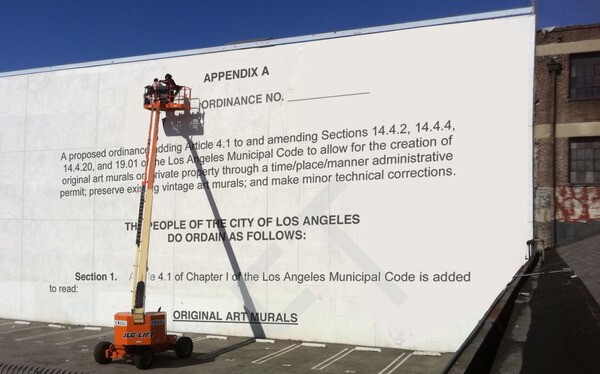Legalizing L.A.'s Murals: Draft Ordinance Introduced, Here are the Details

A major step towards reviving Los Angeles as the centerpiece for the contemporary urban mural movement, a draft ordinance that redefines the art form was introduced today.
In it stakeholders will see a recommendation that has become a mantra from muralists since murals were been banned on the walls of private property: delete the phrase "Mural Sign." When originally called that, the art form was placed under the city's ordinance intended for commercial signs. The law has been under litigation since 2002.
The release of the draft was led by Councilmember José Huizar, whose Distict 14 is prolific with murals, including America Tropical painted by David Alfaro Siqueiros at Olvera Street in 1932.
Keeping things simple is a key for murals to prosper, says City Planner Tanner Blackman, whose team led the discussion on creating the new ordinance that positions murals as original works of art.
Recommended changes to the Los Angeles Municipal Code would allow "original art murals" through a time/place/manner permit on private property while preserving all existing works by making them compliant through a "vintage art murals" permitting system.
"Today's idea becomes tomorrow's consequences," says Blackman, referring to early decisions that left murals vulnerable to litigation and administrative bureaucracy.
The progressive concept behind the draft ordinance still leaves room, and in fact, invites public comment as to how original art and vintage murals can be defined.
Fees will to be determined by the Planning Department and will be announced after a study.
Even as the definition of murals can be debated endlessly -- like, "can street art be a mural?" -- the city notes its own tradition in murals by defining them, in part, as "public access to original works of art" and "community participation in the creation of original works of art."
"Murals can increase community identity and foster a sense of place if they are located in a manner visible to pedestrians," and "include a neighborhood process for discussion," says the draft.
Private property owners or leaseholders waiting to provide space will find it less problematic. While they cannot profit directly from the piece, compensation to cover costs for the creation and / or maintenance of a mural would be permitted. Plus the building owner -- or leaseholder -- can dictate the mural's content (like a commission).
This will help stem the fines levied against property owners, caught in between rules that had them fined for having an illegal sign, or in some cases, accused of allowing vandals to write on their walls, a common occurrence in the last several years prompting this revision.
Substrates of a mural can include tile, or affixed directly, if not painted. Mechanically-produced or computer-generated images are not allowed, according to the draft. That includes images on vinyl, a reference to building wrap-arounds. And the content of the mural is not allowed to be changed.
Murals will also be prohibited from exceeding the height of its structure, and works are subject to review if placed on a building considered a historical landmark.
The proposed ordinance is not limited just to monumental works. Also introduced is the opening for a process to form an "Original Art Mural" permit or building permit sign-off for smaller projects.
The release of the mural ordinance draft begins a 60-day public comment period. A workshop and public hearing will be held at City Hall on January 10, 2012; written comments will be accepted until February 8, 2012.
After the comment period, the city will take the feedback, revise the draft, and report to the Cultural Affairs and City Planning commissions, tentatively scheduled for March 2012.


